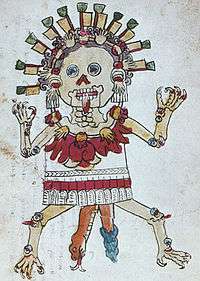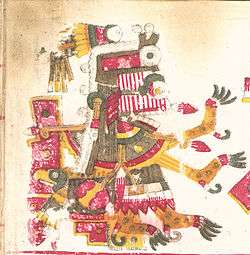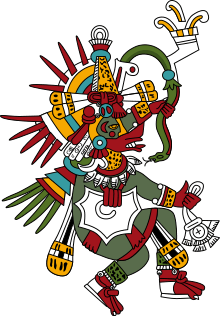Tzitzimitl
In Aztec mythology, a Tzitzimitl [t͡siˈt͡simit͡ɬ] (plural Tzitzimimeh [t͡sit͡siˈmimeʔ]) is a monstrous deity associated with stars. They were depicted as skeletal female figures wearing skirts often with skull and crossbone designs. In Postconquest descriptions they are often described as "demons" or "devils" - but this does not necessarily reflect their function in the prehispanic belief system of the Aztecs.[1]


The Tzitzimimeh were female deities, and as such related to fertility, they were associated with the Cihuateteo and other female deities such as Tlaltecuhtli, Coatlicue, Citlalicue and Cihuacoatl and they were worshipped by midwives and parturient women. The leader of the tzitzimimeh was the goddess Itzpapalotl who was the ruler of Tamoanchan - the paradise where the Tzitzimimeh resided.
The Tzitzimimeh were also associated with the stars and especially the stars that can be seen around the Sun during a solar eclipse. This was interpreted as the Tzitzimimeh attacking the Sun, thus causing the belief that during a solar eclipse, the tzitzimime would descend to the earth and possess men. It was said that if the Tzitzimimeh could not start a bow fire in the empty chest cavity of a sacrificed human at the end of a 52-year calendar round, the fifth sun would end and they would descend to devour the last of men.[2] The Tzitzimimeh were also feared during other ominous periods of the Aztec world, such as during the five unlucky days called Nemontemi which marked an unstable period of the year count, and during the New Fire ceremony marking the beginning of a new calendar round - both were periods associated with the fear of change.
The Tzitzimimeh had a double role in Aztec religion: they were protectresses of the feminine and progenitresses of mankind. They were also powerful and dangerous, especially in periods of cosmic instability.[3]
In popular culture
Tzitzimitl was one of 8 monsters from around the globe to appear as antagonists in the Be Cool, Scooby-Doo! episode titled "Mysteries On The Disorient Express."[4]
Tzitzimitl are depicted as a high-level demon in the roguelike game Dungeon Crawl Stone Soup [5]
Tzitzimitl is also how the Warlady Skyy Appletini is referred to in the popular webcomic Erfworld.
In the tabletop RPG Pathfinder, the Tzitzimitl are powerful undead creatures associated with outer space.[6]
Tzitzimitl (anglicized as Tzitzimime) is featured on the Cartoon Network series Victor and Valentino in the episode "A New Don". Here she is depicted as a tall black figure with five heads and a constellation style texture. She also had the ability to enter a person's body and control them with sunlight being her weakness.
Tzitzimitl appears in Persona 4 and Persona 4 Golden as a summonable persona.
References
- See Klein 2000 for an analysis of the nature of the Tzitzimimeh in relation to the Aztec belief system.
- Sahagún 1997, p. 153:
cenca nemauhtiloya mitoaya intla quitlamiz in quiqua tonatiuh quilmach çentlaiovaz valtemozque in ţiţimime techquazque
There was great fear. It was said that if [the moon] finished eating the sun, so it was said, all would be in darkness; the Tzitzimimeh would descend here; they would devour us.
- This is the conclusion reached by Cecelia Klein (2000) based on an investigation of the iconographical depictions of Tzitzimimeh by the Aztecs.
- "Be Cool, Scooby-Doo!: 'Mysteries on the Disorient Express'" on IMDb
- "Tzitzimitl - CrawlWiki". crawl.chaosforge.org.
- "Tzitzimitl". legacy.aonprd.com. Retrieved 2018-12-28.
Bibliography
- Sahagún, Bernardino de; Sullivan, Thelma D.; Nicholson, H. B. (1997). Primeros Memoriales. Norman: University of Oklahoma Press.
- Klein, Cecelia F (2000). "The Devil and the Skirt: an iconographic inquiry into the prehispanic nature of the Tzitzimime". Estudios de Cultura Náhuatl. Universidad Nacional Autónoma de Mèxico. 31: 17–62.
